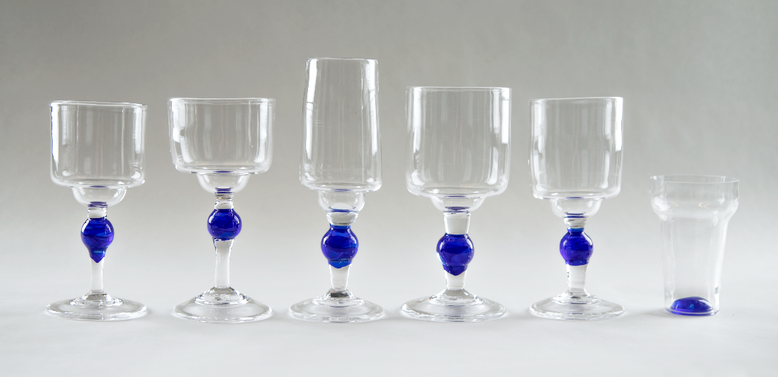DEGREE WORK
TRIND
Trind is the result of a Co-design based project with individuals with afflicted gripping capabilities,
such as osteoarthritis, hemiplegia and rheumatoid arthritis. with these individuals I have produced a series of drinking vessels suitable for their gripping difficulties.
I am autodidact in glassblowing and I made all glass prototypes by my self.
The idea of the drinking vessels is that they should fit for a number of individuals with a gradient of gripping difficulties, allso that they can be in a more general market in addition to assistive products. In this way, I want to be able to include these individuals more in our everyday lives, as these drinking vessels will hopefully be used by people with or without grip difficulties.
What is present in today's market within assistive products is usually plastic drinking vessels, which I consider to be an unpleasant material with associations with disposable items.
Glass in many cultures is seen as something fragile, clean and beautiful. I can say that I do not know anyone who prefers drinking from a drinking vessel in plastic against one in glass.
It can be difficult for new users to start using specially adapted products. Many people prefer to use for them cumbersome tools. It may be partly because they do not want to deviate from normative behavior, it can also be perceived as embarrassing to use assistive products.
During this project i produced a wide range of tools and prototypes, here are some of the most essential design iterations from this project.
MULLE
Mulle is the glass that started this whole project. It has a rounded shape much like a tennis ball that fills out your palm and a midriff that hinder it from slipping from your gripp. In this case it proved very effective for a person with Hemiplegia (paralysis of one side of the body).
MULLE 2
Much like Mulle its based on the idea of filling out your palm, a so called passive gripp but more exaggerated. It is a double sided vessel for hot and cold drink, the bottom side have double layered glass for insulation and is easy to hold without using your hands. It had some problems though with the midriff being to narrow and the cups of the vessel filled out the gripp to much.
MULLE 3
Mulle 3.0 is a combination of the previous two vessels. the stem and foot is hollow and allows for a variety of gripping capabilities. The ball stem is for a passive gripp which is useful for a person with low to non existing grip strength. The foot allows for a pinching grip and it's even possible to hold it with just one finger.
MARBELOUS
Marebelous is a glass I did not purposely design for people with afflicted gripping capabilities, but it worked well for people with rheumatoid arthritis (RA) so i continued from there.
after my first workshop with my focus group which included 3 individuals with rheumatoid arthritis, we ended up with my adjustable goblet tool closely resembling Marbelous
MARBELOUS 2
Marbelous 2 is a smaller version of the previous one. This turned out to be the best alternative I found for a stem for people with RA. Not much more then a ball at 25 m.m. in diameter was needed for a steady gripp. The ball in the stem also lowers the center of mass which makes it harder to accidentally knock over the vessel.
TRIND
Trind is the latest iteration, the only difference between Trind and marbelous 2.0 is the cup part of the vessel. The ridge on the bottom side of the cup fills out the space between thumb and index finger and it rest on the knuckles to allow for a passive gripp.
The walls of the cup are straight or next to straight to make it easier to empty the vessel. I also wanted to give my vessels a inconspicuous look so the user can feel comfortable to drink whatever they want in them.
I based my designs of the vessels on different drinks such as white wine, red wine, champagne and beer. This because proportions are important for different types of drinks to get the desirable characteristics like, the right amount of oxidation wines and to keep champagne bubbly.
TOOLS
During this project i have produced a series of tools that I used in workshops and for exploration purposes.
I developed a adjustable goblet tool for my workshops which worked really well for quick prototyping with almost limitless potential. With this tool I could conjure up a variety of “drinking vessels” much quicker than I could produce them.
Another tool of my making is the silicone hand witch is a human analog for a individual with a paralyzed gripp, it's a replica of my hand in a relaxed state. I made this tool because I can not trust my own hands being fully relaxed when gripping objects.
The gloves I made are based on Cambridge University's simulation gloves from their inclusive design toolkit, which can simulate how it is to have rheumatoid arthritis. The gloves deals pain through the knuckles of the wearer and limits the movement of the fingers. This is a great tool to have when designing for individuals with joint related pain and or limited gripp.















